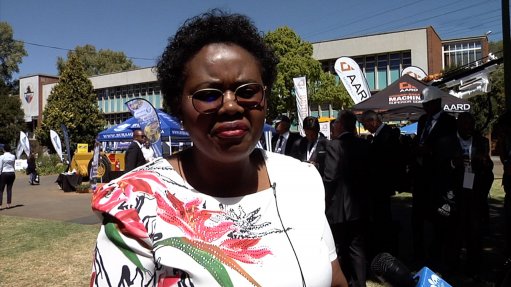
Science & Technology Minister Mmamoloko Kubayi-Ngubane
Science and Technology Minister Mmamoloko Kubayi-Ngubane on Friday stressed the need for the mining industry to embrace the Fourth Industrial Revolution.
Speaking to Mining Weekly Online on the sidelines of the launch of the Mandela Mining Precinct, she reassured the industry that, although mines were increasingly pursuing mechanisation, there would still be jobs for people in the mines.
“We need to balance the benefits of efficient technology against ensuring that jobs are not lost.” For example, mine shafts will still be accessed by mineworkers, but in instances where its depths become untenable for humans to reach, robotics will be used.
The precinct, in Melville, Johannesburg, was officially opened by Kubayi-Ngubane and Mineral Resources Minister Gwede Mantashe.
Mantashe emphasised the importance of mining to the country’s economic wellbeing, as it contributes considerably to foreign earnings and he voiced his excitement for this new endeavour.
The location of the precinct is posited as ideal, owing to its proximity to key universities, its facilitation of mining professional activities, and the space to expand for future developments.
The precinct is set to facilitate the coordination of mining research, development and innovation activities to revitalise the mining sector.
The precinct also aims to support and enhance the local manufacture of mining capital equipment and components, to increase local supply and remedy current currency issues through increased exports.
The precinct is a collaboration between the Department of Science and Technology (DST), through the Council for Scientific and Industrial Research, the Minerals Council South Africa (MCSA), and the universities of Johannesburg, Pretoria and Witwatersrand.
Mandela Mining Precinct co-director Alastair Macfarlane told attendees at the launch that there is much scope for this precinct, owing to the fact that South Africa still contains considerable untapped mineral resources.
However, exploiting these is hindered by factors such as high mining costs. Through this new facility, innovative ways to access resources will be facilitated, and problems will be solved in a collaborative manner.
Industry cluster organisation, the Mining Equipment Manufacturers of South Africa (Memsa), formally established in 2016, aims to grow the local supply chain of capital equipment for the mining industry.
Through its inclusion in the precinct, Memsa will be able to better facilitate this, leveraging expertise and collaborating on projects through daily access to partners such as MCSA, the Department of Trade and Industry, the DST and the South African Minerals Processing Equipment Cluster.
Memsa is already working with Mandela Mining Precinct and MCSA to establish a dedicated test mine where local manufacturers’ newly developed equipment can be tested, Memsa chairperson Freddy Mugeri told Mining Weekly Online.
Local manufacturing will benefit the mining industry owing to shorter supply chains to mines, shorter learning curves and faster customisation of equipment for local mining conditions.
The creation of next-generation jobs and skills development will benefit the manufacturing sector, engendering benefits for the economy of the country as a whole.
Moreover, Memsa is also encouraging its members to export more of their products and to seek market opportunities for those products in industries other than mining, to further extend manufacturing capabilities, indicated Mugeri.
A number of local manufacturers and Memsa members were present at the launch, showcasing their manufacturing capabilities to mining executives, government ministers and other attendees.
MCSA VP Neal Froneman, meanwhile, commented that it was "encouraging to see that, through a learning-by-doing approach, a partnership of stakeholders is evolving to collaborate on the many challenges we face in the journey to mining 4.0”.
He emphasised the role that research and development can play in accelerating the competitiveness, growth and transformation of the mining cluster.